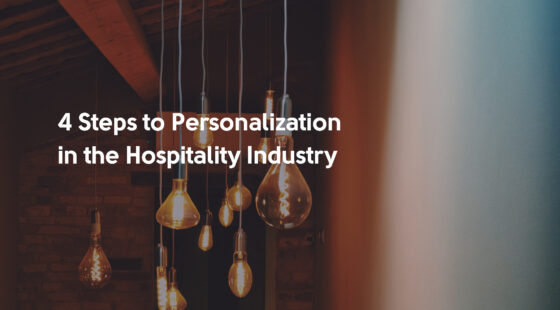Data analytics drives rapid transformation in the travel industry.
Travelers are savvy; they expect hyper-personalized experiences that don’t just make their trips efficient, but memorable. Businesses must leverage real-time insights to optimize pricing strategies, forecast demand, and enhance customer satisfaction.
Airlines, hotel chains, and online travel agencies (OTAs) are shifting from gut-driven decision-making to data-backed strategies that yield greater revenue growth and operational efficiency.
To add to the mix, the competitive landscape is fierce. Understanding customer behavior, seasonality trends, and revenue management is a necessity. Big data, artificial intelligence (AI), and machine learning (ML) help travel companies extract meaningful insights that streamline operations, boost customer loyalty, and maximize profitability.
In this article, we’ll explore how data analytics empowers the travel industry, focusing on three key areas:
Personalization – Enhancing the traveler’s journey with AI-driven recommendations.
Seasonality Management – Predicting demand fluctuations and optimizing inventory.
Revenue Optimization – Using dynamic pricing and forecasting to increase profitability.
We hope to equip you with a greater understanding of how travel companies harness data analytics to stay ahead of market trends and provide unparalleled customer experiences.
Let’s get going!
Personalization and Customer Insights in Travel Analytics
Who would want to be squeezed out of an industry poised to generate $4.34 trillion in online sales by 2028?
Now more than ever, travel companies recognize that personalization is the cornerstone of modern travel, especially when travelers demand seamless, customized experiences. Whether booking a flight, reserving a hotel, or planning a vacation itinerary, today’s consumers expect recommendations that align with their preferences, past behaviors, and even real-time contexts.
With data analytics, AI, and ML, travel companies can gain deep customer insights to deliver hyper-personalized experiences. The ability to predict what travelers want before they even search for it allows brands to improve customer satisfaction, retention, and revenue generation.
How Data Analytics Enhances Personalization in Travel
Did you know that Gen Z and Millennials prioritize spontaneous, experience-based trips? Younger generations are 30% more likely to book trips two weeks in advance compared to older generations.
1. Behavioral Analysis & Predictive Recommendations
Analyzing historical booking data, browsing behavior, and user preferences helps travel companies accurately predict future traveler needs.
For example, an online travel agency OT) can use machine learning algorithms to:
- Recommend hotels based on past stay preferences (e.g., a traveler who booked luxury hotels in Paris may receive similar recommendations in Rome).
- Suggest flight upgrades or premium seat selections for frequent business travelers.
- Provide personalized activity suggestions based on a traveler’s past interests.
Research shows that 71% of travelers now expect personalized recommendations when booking trips and businesses that deliver personalization see a 10-15% revenue uplift.
2. AI-Driven Chatbots & Virtual Assistants
Research shows that 52% of travelers expect AI-driven assistance for travel-related inquiries, and 44% expect enhanced guest engagement.
AI-powered chatbots and virtual assistants are redefining real-time customer engagement. These tools analyze user queries, past interactions, and contextual factors to provide personalized assistance without human intervention.
For instance, a chatbot can:
- Offer real-time flight status updates and alternative routes in case of delays.
- Suggest restaurant and activity recommendations based on a traveler’s location and preferences.
- Provide automated check-in assistance and boarding reminders
3. Personalized Pricing & Loyalty Programs
McKinsey reports that companies that excel in personalization achieve 40% more revenue than their competitors.
One-size-fits-all for pricing strategies? Not anymore. Companies adjust pricing based on demand, user behavior, and real-time market conditions through dynamic pricing models powered by data analytics.
Example of how personalized pricing works:
An airline may offer exclusive discounts to frequent flyers who regularly book premium-class seats.
Hotels may provide customized room upgrade offers for loyal customers.
OTAs can create dynamic package deals that align with past booking patterns.
Loyalty programs also benefit from data analytics, as companies can:
- Segment travelers based on spending habits and frequency of travel.
- Offer personalized promotions for inactive users to encourage rebooking.
- Optimize reward structures to increase engagement.
A report found that 47% of consumers use AI to plan travel within loyalty programs, while 45% of brands cite integrating AI into their loyalty strategy as a top challenge.
4. Sentiment Analysis & Customer Feedback Loops
According to Expedia, travel brands using sentiment analysis to improve customer service see a 12% increase in positive reviews and a 9% reduction in negative feedback.
Understanding how customers feel about a brand is critical for long-term success. With natural language processing (NLP) and sentiment analysis, companies can analyze customer reviews, social media interactions, and survey responses to gauge traveler sentiment.
Case scenarios of how travel brands use sentiment analysis:
- Airlines can detect negative sentiment in social media complaints and provide proactive service recovery.
- Hotels can analyze guest reviews to identify recurring issues (e.g., noise complaints in specific rooms).
- OTAs can measure customer satisfaction based on booking experience feedback and refine their recommendation engines.
Seasonality Management in Travel Analytics
Over 48% of Americans planned to travel during the holiday season in 2023, up from 31% in the previous year. 85% of travelers planned to get away at least once during the summer months.
One of the key good things about the travel industry is that it operates in predictable cycles. Demand fluctuates based on seasonality, holidays, and events. Airlines, hotels, and online travel agencies navigate high seasons, low seasons, and shoulder periods while ensuring optimal occupancy rates, pricing strategies, and revenue generation.
Traditionally, businesses relied on historical trends and manual forecasting to anticipate seasonal demand. However, with data analytics and machine learning, companies now gain real-time insights into traveler behavior, making it possible to adapt pricing, promotions, and inventory allocation dynamically.
How Travel Businesses Use Data Analytics to Manage Seasonality
| Challenge | Traditional Approach | Data-Driven Approach |
| Predicting Demand Peaks | Relying on historical trends and intuition. | AI-powered forecasting using real-time market data, booking velocity, and external event tracking. |
| Managing Low-Season Revenue | Blanket discounts with no customer targeting. | Personalized promotions based on historical travel behavior and demand forecasting. |
| Avoiding Overbookings or Empty Seats | Manual adjustments based on guesswork. | Predictive analytics for optimal inventory allocation and pricing. |
1. Predicting Peak Demand with AI-driven Forecasting
According to research, travel brands using AI-powered demand forecasting experience a 20-30% improvement in revenue during peak seasons by optimizing inventory and pricing strategies.
Predictive forecasting is one of the most valuable applications of data analytics in seasonality management.
For example, a resort chain can use machine learning algorithms to:
- Predict booking surges around long weekends, public holidays, or major sporting events.
- Adjust room rates dynamically to maximize revenue during peak seasons.
- Allocate staffing and resources efficiently to accommodate higher guest volumes.
2. Dynamic Pricing for Seasonal Adjustments
Pricing is one of the most influential factors in consumer decision-making, especially in the travel industry, where costs fluctuate based on demand. Dynamic pricing models powered by real-time data analytics allow travel businesses to adjust pricing strategies based on demand, competitor rates, and external conditions.
How dynamic pricing works in travel:
- Airlines adjust ticket prices based on seat availability, time before departure, and competitor pricing.
- Hotels increase rates during peak tourist seasons but offer discounted packages during off-peak months to fill vacancies.
- Car rental companies raise prices during high-demand events (e.g., the Super Bowl or music festivals) while providing promotions during low seasons to maintain business.
Consider the case of airlines, which have long been pioneers of dynamic pricing models. Using sophisticated algorithms, they adjust fares based on a multitude of factors, including seat availability, demand fluctuations, fuel costs, and even traveler browsing behavior. For instance, if an airline detects that a specific flight is filling up faster than expected due to an upcoming business conference, it may increase fares in real-time to capitalize on the heightened demand. Conversely, if a flight remains underbooked closer to departure, the airline can lower prices or offer last-minute deals to encourage ticket sales and avoid flying with empty seats.
A study found that travel brands implementing dynamic pricing see a 15-25% increase in revenue, as customers are more likely to book when presented with time-sensitive, demand-based pricing.
3. Inventory & Resource Optimization: Avoiding Overbookings and Empty Seats
Research indicates that better inventory forecasting reduces overbooking penalties by 40% while increasing revenue from last-minute bookings.
For airlines, hotels, and tour operators, mismanaging inventory can be costly—overbooking leads to dissatisfied customers, while underutilization results in revenue loss. Data analytics allows businesses to optimize resource allocation by predicting occupancy rates, seat availability, and operational demands.
How travel brands optimize inventory with data analytics:
- Airlines use real-time seat occupancy data to adjust flight schedules and offer last-minute promotions for underbooked flights.
- Hotels analyze historical occupancy trends to determine when to launch targeted discounts.
- Cruise lines predict passenger capacity across travel seasons, optimizing cabin availability and onboard services.
For example, a budget airline analyzing seasonal booking data might find that its Friday evening flights to a popular weekend getaway consistently sell out. In contrast, its Saturday morning flights remain half-empty. By recognizing this pattern, the airline can shift additional aircraft capacity to Friday evenings, increasing profitability while optimizing resources.
4. Marketing & Promotions Tailored to Seasonal Trends
Seasonally targeted campaigns ensure that businesses reach the right audience with the right offer at the right time.
How data-driven seasonal marketing works:
- Airlines launch early-bird flight discounts months before peak travel periods (e.g., summer vacations).
- Hotels target business travelers with corporate discounts during low seasons.
- OTAs promote last-minute getaway deals based on real-time search trends.
With AI-powered segmentation, travel brands can:
- Identify which customer segments travel during peak vs. off-peak seasons.
- Personalize promotions based on historical booking behaviors.
- Use geo-targeting to promote travel deals to travelers based on their location.
An insights report found that personalized seasonal promotions drive up to 50% higher conversion rates compared to generic travel marketing campaigns.
Revenue Optimization in Travel Analytics
Effective revenue management is crucial for travel businesses in an industry where pricing can change by the second and profit margins are highly dependent on fluctuating demand. Airlines, hotels, and OTAs must balance competitive pricing, inventory utilization, and profitability while ensuring customer expectations and market trends are accounted for in real time.
The traditional approach to revenue management was largely reactive, relying on historical data, manual adjustments, and broad market trends to guide pricing and booking strategies. However, with the rise of big data, artificial intelligence (AI), and machine learning (ML), revenue optimization has evolved into a highly sophisticated, dynamic process.
This section explores how data analytics empowers travel businesses to optimize revenue streams, covering dynamic pricing, demand-based inventory allocation, and real-time revenue monitoring strategies.
How Data Analytics Optimizes Revenue Across the Travel Industry
| Travel Sector | Traditional Revenue Approach | Data-Driven Revenue Optimization | Impact on Profitability |
| Airlines | Fixed ticket pricing with periodic manual adjustments. | Dynamic pricing is based on real-time booking patterns, competitor pricing, and external factors (weather, economic conditions). | 5-15% revenue increase through AI-driven pricing strategies. |
| Hotels & Resorts | Seasonal rate adjustments based on past occupancy trends. | AI-driven occupancy forecasting, predictive pricing, and personalized guest promotions. | 20-30% increase in seasonal revenue through optimized pricing and targeted promotions. |
| Online Travel Agencies (OTAs) | Static discount models and generic promotions. | Personalized pricing and predictive deals based on customer segmentation and search behavior. | 10-15% increase in booking conversions with AI-powered dynamic discounts. |
| Cruise Lines & Tour Operators | Fixed itinerary pricing with last-minute deep discounts. | Demand-based itinerary adjustments, and automated pricing fluctuations based on customer interest and economic indicators. | 15-25% improvement in revenue per available booking. |
1. Dynamic Pricing
The travel industry operates on supply-and-demand economics, where pricing fluctuations are essential to maximizing revenue and ensuring optimal utilization of resources. However, unlike static pricing models that adjust rates only periodically, modern dynamic pricing algorithms leverage real-time data analytics to modify prices instantaneously based on a range of factors.
Dynamic pricing is powered by machine learning models that continuously analyze:
- Booking velocity: how quickly customers are purchasing flights, rooms, or tickets.
- Competitor pricing: adjusting fares or rates to remain competitive.
- Traveler profiles: offering personalized discounts or promotions based on past behavior.
- Seasonal trends and local events: raising prices when major concerts, festivals, or holidays drive demand.
- Real-time external conditions: adjusting rates based on currency fluctuations, fuel prices, or geopolitical events.
For instance, if an airline notices that a specific route is selling out quickly, its pricing algorithm may increase fares dynamically for remaining seats, ensuring that last-minute travelers pay a premium. Conversely, if bookings are lower than expected, the system might trigger price reductions or promotional discounts to stimulate demand.
2. Demand-Based Inventory Allocation
According to a report, airlines that optimize inventory allocation through data analytics increase revenue per available seat (RASM) by up to 7%, as fewer seats go unfilled.
Optimizing revenue is about pricing and how and when inventory is allocated or different customer segments.
With predictive analytics, companies can adjust inventory distribution based on demand forecasts, ensuring that:
- Premium seats or rooms are reserved for high-value customers willing to pay a premium.
- Off-peak inventory is bundled with promotions to attract budget-conscious travelers.
- Underperforming routes, rooms, or services are repackaged to maximize occupancy or utilization.
For example, an airline may reserve first-class and business-class seats for corporate travelers who are more likely to book at a higher price closer to departure. Meanwhile, budget-conscious travelers looking for economy fares may receive discounted last-minute offers to fill empty seats, ensuring no revenue opportunity is lost.
3. Real-Time Revenue Monitoring & Adjustments
Revenue optimization also entails continuous monitoring and real-time adjustments. Through real-time data dashboards and AI-powered analytics, businesses can:
- Detect sudden drops in demand and adjust pricing or promotions accordingly.
- Monitor competitor pricing strategies and respond in real-time to remain competitive.
- Identify high-performing revenue channels and allocate resources efficiently.
- Track customer spending patterns to offer personalized upsell opportunities.
For example, an OTA using real-time revenue analytics may notice that bookings for a particular destination suddenly slow down, signaling a potential demand dip due to external factors like weather conditions or economic concerns. Instead of waiting for manual reports, the system can automatically trigger promotional campaigns or flash discounts to stimulate bookings before the revenue loss becomes significant.
Data-Driven Success in the Travel Industry
Companies that once relied on manual forecasting and static pricing models are now harnessing the power of AI, big data, and machine learning to drive smarter decision-making and gain a competitive edge in an increasingly dynamic market.
Through personalization, seasonality management, and revenue optimization, travel businesses can enhance the customer experience while ensuring operational efficiency and profitability.
As technology evolves, the travel industry will see even more sophisticated data analytics tools, AI-powered automation, and predictive intelligence solutions emerge. We expect that the next phase of data-driven transformation will focus on:
- Real-time AI forecasting that adjusts pricing and marketing strategies instantly.
- Sustainable travel analytics that helps businesses optimize eco-friendly operations.
- Blockchain and fintech innovations that streamline travel payments and fraud detection.
- 5G-enabled connectivity that improves real-time traveler insights and dynamic service offerings.
Are you ready to leverage data analytics for smarter personalization, seasonality management, and revenue optimization? Whether you’re an airline, hotel, or OTA, implementing advanced analytics strategies with the help of a seasoned data analytics expert like Svitla Systems can unlock new levels of efficiency and profitability.
Talk to our Svitla Systems data analytics experts today and future-proof your travel business with AI-powered insights.

![[Blog cover] Data analytics in travel industry use cases](https://svitla.com/wp-content/uploads/2025/02/Blog-cover-Data-analytics-in-travel-industry-use-cases-936x527.jpg)


